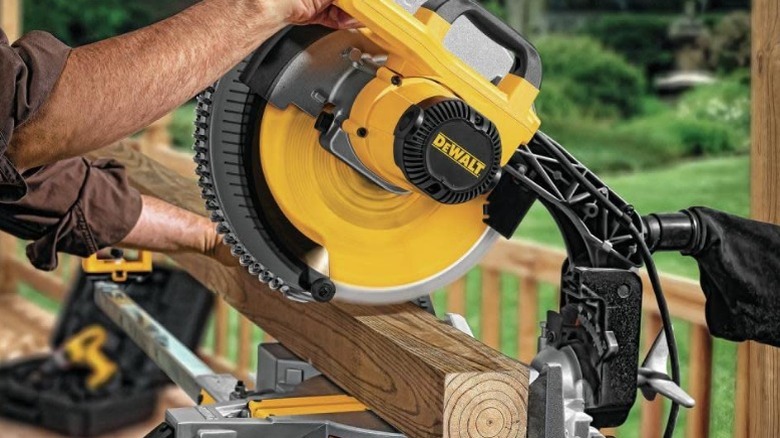Miter Saw Vs. Table Saw: Which Should You Get For Your Woodworking?
We may receive a commission on purchases made from links.
Woodworking can be an expensive hobby, and there aren't many people out there who can afford to drop thousands of dollars on a fully kitted-out woodshop on day one. Most craftsmen build their collection one tool at a time, shopping the sales or purchasing each new power tool whenever the need arises. This is particularly tricky when it comes to large purchases, like power saws. A good circular saw from a major brand will take you pretty far when you're starting out, but there comes a time when you're going to want to pick up a specialty saw that will allow you to perform more complicated and meticulously measured cuts with less setup. These can be quite expensive, however, and so budgeting for them may require you to space out your purchases. This leaves you in the awkward position of choosing which of these tools is better suited to your immediate needs.
Table saws and miter saws are two tools that just about every woodworker will want to have in their shop. They're both incredibly useful and will likely end up getting more cutting time than just about any other tool you own. But which should you buy first? These saws work very differently, and so choosing the right one for you ultimately comes down to the kinds of woodworking projects that you plan on doing. I've been working with both of these tools for the better part of a decade, and I've found that, while they are both useful for all sorts of projects, they each have certain strengths that lend them to specific types of work.
Miter saws are better for larger construction projects
Miter saws (sometimes called chop saws) are hands down the best tool for breaking down boards into shorter lengths. They use blades that are specifically designed for cutting across the grain of wood while remaining cool, maintaining a sharp edge, and minimizing chip-out. Most cut in a downward "chopping" motion, though some of the nicer models are also able to extend out on an articulated arm and then cut across the width of larger boards. The device itself has a built-in shelf that can be used as a brace to keep the board straight. The blade itself can also rotate at various angles so that you can make angled cuts, beveled cuts, and compound cuts.
A miter saw can cut quickly, easily, and precisely, with little fuss and minimal setup. This makes it an ideal tool for construction work. It's the best saw for chopping up 2x4s to make wall frames, cutting boards into shelves, cutting boards for a deck, fence, or garden bed, cutting moulding and baseboards, cutting angled corners for picture frames, or cutting boards to length for glue-ups to make things like desks and tabletops. I recently put mine to work building yard games like giant Jenga, ring toss, and an end-grain knife throwing block. Basically, a miter saw will be your go-to for pretty much any project that involves turning a lot of long boards into shorter ones. It's also good for cutting very small pieces that would be difficult or dangerous to cut with other tools.
There are two big drawbacks to miter saws: They can't perform rip cuts (cuts along the length of a board where the blade moves in the same direction as the wood grain), and they can't cut larger sheet goods.
Table saws are better for fine woodworking
Table saws require a bit more setup and skill than a miter saw, but the reward is an incredibly versatile saw. It's difficult to list all the ways that you can cut wood on a table saw because it's able to make cross, rip, and mitered cuts, meaning it can do just about every type of straight cut there is if you have the right saw blades and accessories.
The two main methods are by using a rip fence as a guide for standard rip cuts and a miter gauge for cross cuts. But there are also innumerable sleds and jigs that you can purchase or build for table saws that expand their capabilities even further. For instance, I made a simple 90-degree crosscut sled when I needed to build a set of nine floor-to-ceiling bookshelves, and the boards were too wide to cut with my miter saw. Other jigs may help in achieving more complex tasks, such as tapered cuts. But while table saws are capable of doing just about anything, they truly excel at rip cuts along the length of the board and precision joinery. Resizing boards that are too wide, making beveled or angled rip cuts, cutting sheet goods for boxes and cabinetry, cutting dados, rabbets, and box joints–all of these are tasks where a table saw is easily the best option.
A quality woodworking table saw's ability to make nearly any kind of cut makes it a better universal option than a miter saw, and its precision makes it ideal for fine woodworking tasks and advanced forms of joinery. That said, repeated crosscuts can be a chore on a table saw when compared to the miter saw. You'll have to decide for yourself which is better suited to your needs.


